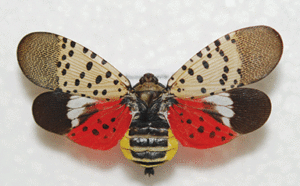
The adult spotted lanternfly. greyish-tan front wings with black spots and a net-like pattern on the tips. Their hind wings have a patch of red with black spots, followed by a white band and a black tip. (Photo courtesy Pennsylvania Department of Agriculture)
The spotted lanternfly (Lycorma delicatula ) is an invasive planthopper from China, India and Vietnam.
First found in the United States in 2014 in Berks County, Pa., it has since spread to northern Delaware, southern New York, and northern Virginia.
Although Maryland is fortunate not to have a confirmed finding of this pest, vigilance is in order to prevent its spread and establishment into our state.
Spotted lanternflies have four immature or nymph stages.
Younger nymphs are black with white dots on along their body and legs, while older nymphs are bright red with black stripes and white dots along their body. They look very similar to some of our common stink bug nymphs, however, spotted lanternfly nymphs have short antennas, and their spots are in a domino-like pattern.
Adult spotted lanternflies are 2.5 centimeters in length.
Their front wings are greyish-tan with black spots, with a net-like pattern on the tips.
Their hind wings have a patch of red with black spots, followed by a white band and a black tip.
Their body is mainly black except for their abdomen, which is yellow with brown bands.
Adult flies lay eggs in the fall, in groups of 30-50 on host plants, or other flat vertical surfaces, such as rocks, wood posts and trash cans.
The irregular distribution and spread of the insect is thought to be caused by people moving infested material or items containing egg masses.
Eggs hatch in late spring — early summer and nymphs will feed for 8-10 weeks before becoming adults. Adults are active from early July until winter.
Spotted lanternfly adults and nymphs frequently gather in large numbers on host plants and can be found moving up and down the stem or trunk of the plant.
All stages of the pest feed by sucking sap from plants.
They have been found to feed on over 50 species of plants, but their preferred hosts are the tree of heaven (Ailanthus altissima), apple trees, stone fruit trees, pine trees, and grapes. As they feed they excrete a sticky sugar-rich fluid called honeydew, which attracts other insects such as ants and wasps and causes sooty mold to grow.
Spotted lanternfly also has been found on other crops, such as corn, soybeans, and alfalfa, although there has been no observed feeding on these plants.
If you observe any egg masses or insects which look similar to this, try to collect them, and contact the Maryland Department of Agriculture at 410-841-5920 or e-mail DontBug.MD@maryland.gov as soon as possible.
(Editor’s note: Emily Zobel is an agriculture and natural resources agent for University of Maryland Extension in Dorchester County.)



